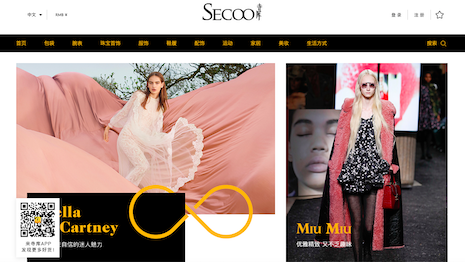 Secoo is one of the leading Chinese platforms selling luxury products online and via mobile. Image credit: Secoo
Secoo is one of the leading Chinese platforms selling luxury products online and via mobile. Image credit: Secoo
NEW YORK – Five considerations should determine which platforms to use to enter the Chinese luxury ecommerce sector as brands tackle the where, when and how questions relating to tapping the potential of the world’s most insatiable luxury market.
Tmall and Alibaba shape most of the perception of ecommerce in China, according to Pablo Mauron, partner and China managing director of Digital Luxury Group (DLG). The digital agency’s Luxury Society division was host yesterday of a breakfast event at the Four Seasons Hotel Downtown focused on the China ecommerce opportunity.
“The key is not where to start, but how much can you afford to start,” Mr. Mauron told an audience of 60-plus luxury executives involved with the China market.
Luxury Society has 30,000-plus members and hosts select events in key markets such as New York, Paris and Shanghai, cities where its parent DLG has offices to serve its luxury brand clientele.
High five
In his session, Mr. Mauron highlighted the key considerations that marketers should take into account when picking platforms to tap into the Chinese ecommerce opportunity.
First is awareness. Ecommerce does not equate awareness. However, activation equals awareness. But it does take the right partner to launch.
“It’s always the struggle of international brands entering China,” Mr. Mauron said. “Activations come at a cost.”
What brands need to focus on is the right platform for the right attention.
“So you need to find the right match and it’s not that different from launching in a bricks-and-mortar location,” Mr. Mauron said.
The second consideration is audience. Most marketers eyeing China are “fooled by the numbers,” Mr. Mauron said.
For luxury brands, they are often targeting the 1 percent or subset of that.
More importantly, the target audience might be there, but are they there for the brand?
Marketers must tie audience with category and demographics to gain an idea of conversion rates. They must also ask two questions: Who are you after? Who are they [targeted audience] after?
“The higher the spending power, the higher the expectation from exclusivity,” Mr. Mauron said.
Then, of course, is tying the merchandise into the audience’s tastes and emphasis on exclusivity. Focus on exclusives, hero products, bestsellers and core products, while also keeping an eye on worst sellers, old collections and dead stocks.
Another reality of China is discounting, with the country being among the most price-sensitive luxury markets.
“Eighty percent of the online platforms in China offer discounts,” Mr. Mauron pointed out. “Only 40 percent of online platforms are offering full price and 60 percent offer flash sales.”
 DLG China managing director Pablo Mauron addressing executives at his agency's China ecommerce opportunity breakfast event Aug. 19, 2019 in downtown Manhattan. Image credit: DLG and Luxury Society
DLG China managing director Pablo Mauron addressing executives at his agency's China ecommerce opportunity breakfast event Aug. 19, 2019 in downtown Manhattan. Image credit: DLG and Luxury Society
Brand protection is the third consideration.
“If a brand sells in China, it sells online,” Mr. Mauron said. “Your products are there already.”
Daigou, or personal shoppers who buy abroad for customers at home, have for long been a key purchasing channel, although a recent government imposition of duties may make it a less attractive option than in-country or cross-border ecommerce sales.
Aligning official product availability in Chia is key as well. Brands must give consumers a reason to shop locally.
“The gray market is a headache,” Mr. Mauron said.
The executive recommended working with platforms to sync product availability and promotions.
Brands should also work on flagship store and distribution setup to avoid retail arbitrage.
The fourth consideration for marketers is infrastructure.
Building non-platform ecommerce requires IT, warehousing, fulfillment, delivery, customer service, merchandising and storefront, which is often WeChat. It all has to tie into an effective user experience.
“Independence comes at a cost,” Mr. Mauron said.
Therefore, the chosen platforms must offer white-glove service that brands cannot get on their own. Sixty percent of platforms in China offer special packaging, for example.
The final consideration in picking platforms is getting started.
“We don’t believe there’s a one-size-fits-all approach in China,” Mr. Mauron said.
Marketers have to factor in brand equity, budget and revenue goals.
“It’s about your capacity to invest,” Mr. Mauron said.
“The more sophisticated you are in ecommerce setup,” he said, “the more your costs will go up.”
